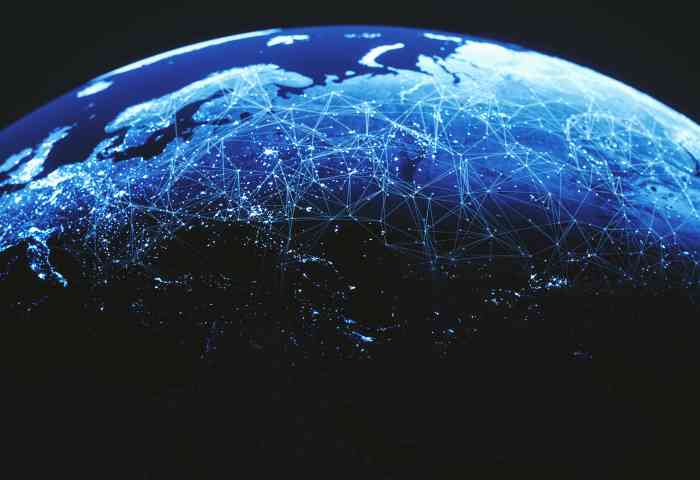Get started with Mizzou
Apply hereMaster of Science
The wealth of geospatial data available is a game changer for many industries. Using a variety of sources, we can gather insight into human behavior, population shifts, weather patterns and more. The field of data science and analytics has transformed how we interpret this data. From data visualization to trend monitoring and decision-making, this field is constantly evolving.
The online Master of Science in Data Science and Analytics with an emphasis in Geospatial Analytics from Mizzou empowers you to join this growing discipline. Our program builds your expertise in geospatial data analysis. You'll learn the principles, tools and applications of the field through hands-on experience. That real-world experience will make you an asset to any potential employer.
You'll be provided a comprehensive introduction to the overall field of data science and analytics. Once you've covered the basics, you'll move on to assessing geospatial information. Utilizing the latest in big data sets and machine learning tools, you'll take a deep dive into information that forms our world. Using what you've learned, you'll analyze and draw insights from large data sets wiwth guidance from Mizzou's renowned faculty.
Explore other emphasis areas from Mizzou's master of science in data science and analytics:
Quick facts
Official name
Master of Science in Data Science and Analytics with an emphasis in Geospatial AnalyticsCampus
Program type
Master's degreeAcademic home
Graduate School | MU Institute for Data Science and InformaticsDelivery mode
100% onlineAccreditation
Higher Learning CommissionCredit hours
30Estimated cost
$32,514.00*This cost is for illustrative purposes only. Your hours and costs will differ, depending on your transfer hours, your course choices and your academic progress. See more about tuition and financial aid.
About the in Geospatial Analytics program
Location-based data influences several industries and developments in our world. From tracking weather and population trends to overseeing urban planning and infrastructure efforts. Surveying and the use of GIS shapes these industries for decades. Geospatial analytics streamlines data-gathering and interpretation processes and allows for an increasingly granular level of information.
Geospatial analytics involves compiling data from across multiple spatial and nonspatial sources. Analysts then assess the information available to identify patterns and create visualizations. These visualizations can take many forms depending upon what information needs to be conveyed. They may focus strictly on the landscape and an area’s geographic features. Or, they might examine people and their habits over a region. They could also consider historical shifts, especially in relation to current events.
The online master's in geospatial analytics:
- Enhances your knowledge in industry technologies and applications.
- Takes a multidisciplinary approach to expand your understanding of big data.
- Demonstrates data's influence on geospatial analytics.
- Teaches you statistical analysis, database system management, information retrieval, data mining and machine learning.
- Introduces you to tools and techniques used across all data science applications.
- Helps you consider data analytics as an integral decision-making tool.
- Touches on current trends in data science and analytics and how they continue to shape the use of geospatial information.
- Provides industry issues you’ll counter with digital imagery, thermal imaging and more.
- Shows you how to acquire and analyze large data sets.
- Covers how to communicate your findings through data visualization.
- Teaches you to utilize geospatial data stored in several formats.
- Provides you experience in managing, accessing and manipulating geospatial information.
- Goes over ethics and security for protecting data collections potentially containing sensitive information
- Integrates hands-on learning to improve your familiarity of data analysis tools and techniques.
- Covers the key concepts and techniques of remote sensing.
- This includes spatial and spectral characteristics for passive, active, thermal and other phenomenologies.

Career prospects
Enhance the skills you bring as a cartographer or geoscientist, both predicted to see steady growth between 2020 and 2030.
Beyond these two fields, this online master’s in geospatial data science and analytics prepares you to identify, monitor and communicate geographic and population patterns in telecommunications, urban development, agriculture, the military, natural resources, transportation, logistics, meteorology, energy industry and business. Possible job titles include:
- Geospatial information scientist
- Geospatial asset manager
- Geospatial analytics engineer
- Geospatial technician
Program structure
As you begin the online master’s in geospatial analytics, you’ll start with a rigorous 16 credit-hour core. Then, you'll proceed onto the concentrated focus of the geospatial analytics emphasis area (nine credit hours). After, you'll get additional hands-on experience through a case study (two credit hours) and a capstone project (three credit hours).
All courses are held online in eight-week modules using a semester structure, allowing you to complete the program in about two years. Additionally, you have the opportunity to attend an optional, on-campus Data Science Week in the spring. There you can collaborate with and gain real-world insights from our faculty members and partnering industry professionals.
During the core sequence, you’ll develop a strong foundation in all data science and analytics principles. This includes its statistical formulas and methods for accessing, cleansing, modeling, analyzing and visualizing data. You’ll further learn about the design, management and function of database systems, ethics for various industries and settings, data collection and storage security and applied machine learning and modeling.
As the culmination of the online master’s in data science and analytics program, you’ll participate in a team case study project. This experience paves the way in terms of practice and reinforcement for your team capstone project.
Coursework includes
- Spatial and geostatistical analysis, including common concerns with using, implementing and assessing spatial data
- Theoretical and practical issues involved in geospatial data engineering, including access, indexing, retrieval, storage, management and its place in the full data science lifecycle
- Remote sensing data analytics and information extraction, with emphasis on raster data sets and processing
Delivery
100% onlineCalendar system
Semester-basedTypical program length
2 yearsAccreditation
The University of Missouri is accredited by the Higher Learning Commission, one of six regional institutional accreditors in the United States.
Faculty spotlight

Chi-Ren Shyu has organized and chaired technical program committees for several Institute of Electrical and Electronics Engineers (IEEE) conferences, such as IEEE HealthCom, IEEE BigMM, IEEE BIBM and more. He represents the University of Missouri (Mizzou) serving on the Southeast Conference (SEC) Artificial Intelligence Curriculum Consortium. Since joining Mizzou in 2000, Shyu has received the National Science Foundation CAREER award, Engineering Faculty Research Award, Engineering Teaching Excellence Award and more. His current research focuses on digital health, explainable AI, quantum computing and spatial big data analytics. He is a Fellow of the American Medical Informatics Association.
